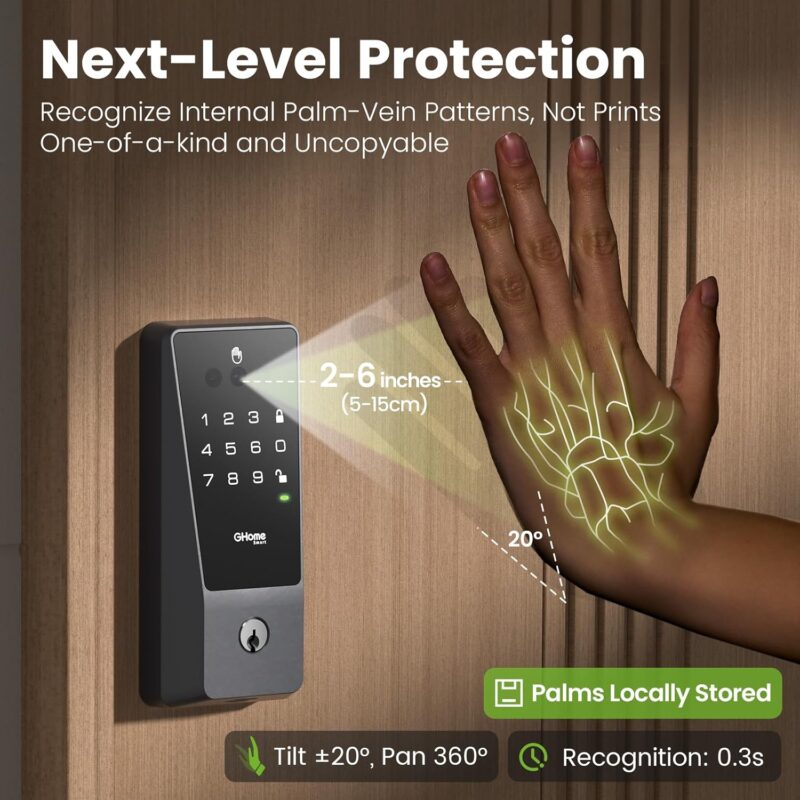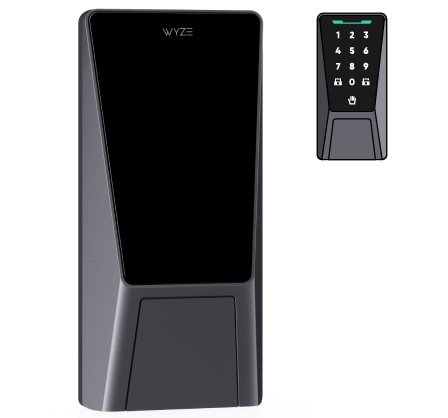Looks like our favorite (not really) purveyor of value smart home gadgetry, Wyze, is about to dip its toes into even more personal biometrics. Forget fingerprints – those are for Luddites. Whispers on the digital wind (along with in-app renders) suggest Wyze is gearing up to launch a new smart lock that wants to get *real* familiar with your hand. We’re talking touchless unlock by scanning the unique vein patterns in your palm, from a few inches out. Cutting edge or just creepy? With Wyze, it can always be both!
This yet-to-be-announced marvel of modern (rebranded) engineering, featuring a Cybertruck design ethos, is expected to be a Lockin variant of this. And if you know Wyze, you know “variant” often means they found a gadget on a sourcing trip, slapped their logo on it, and called it a day.
Naturally, because even Wyze understands that sometimes “future tech” is just future-problematic, there are backup plans to hand scanning. The expected smart lock features a numeric touchscreen for good old-fashioned code entry. And for those truly “oh crap” moments when the battery dies (because, let’s be honest, it will), a hidden keyhole and a USB-C charging port should save your bacon. Other expected features include an rechargeable USB-C battery, versus endless AA rotation as on the Wyze Bolt and countless other locks.

Now, let’s address the elephant in the room, or rather, the tariff bill on the shipping container. Wyze has built its empire on being the friendly neighborhood storefront for astonishingly cheap Chinese smart home gadgets. The problem? Those “astonishingly cheap” days might be numbered. With new and hefty tariffs being slapped on imports from China – we’re talking instances where the tariff costs *more* than the goods themselves – Wyze’s whole business model is looking a bit shaky as the company publicly lamented a $255,000 USD tariff bill on a $167,000 USD shipment of floodlights.
The uncomfortable truth is that Wyze products, while inexpensive, often carry that special “junky” patina. Customer reviews are a vibrant tapestry of “it’s great for the price!” woven with threads of “it stopped working after a week,” “connectivity is a nightmare,” and “their security is Swiss cheese.” CNET even put Wyze in the naughty corner for a while, hesitant to recommend their cameras after some rather unfortunate security oopsies.
So, as Wyze potentially brings this palm-scanning portal to our doors, one has to wonder. Will the “wow” factor of unlocking your home with a casual wave of your hand be enough to distract from the inevitable price hikes? And will that higher price suddenly make the “charming quirks” of Wyze hardware feel a lot less charming and a lot more like, well, just plain cheap?
Get ready to open your palm, and probably your wallet a bit wider than you’re used to if you want to stay in the Wyze ecosystem. The era of truly inexpensive Wyze might be waving goodbye, even if their new lock is just learning to wave hello.

I wonder how unique that vein pattern really is. Just because something can be done doesn’t mean it should be.
On the tariff matter, I’d guess Wyze can move to another country’s supplier a lot faster than an auto manufacturer can move. Appliance manufacturing has been moving around a lot over the years. It’s not like China is the only country with capacity.
And again, a reminder on Wyze security. All IoT devices should connect to a guest network. Even Alexa devices don’t need to talk to one another on the same network, which is surprising because they do need to decide which device will respond when two devices hear a command.
Except “Wyze” is mostly a storefront for Chinese-designed and built products. But their primary Chinese partner (Hualai) now has a presence in Singapore and Vietnam. So they are indeed, albeit indirectly, diversifying. Unfortunately, for this post/topic, their Lockin/Chongqing Luxiangjia Technology locks look to be 100% Chinese sourced at this point in time.
This is the same technology as Amazon’s palm scanners in Whole Foods stores, right?
From what they said in an AMA, Wyze hasn’t been doing ODM manufacturing for new products in the last couple of years now and things have been developed concept to design to prototyping and testing and everything all in house now.
I’ve been a long-time reader because of your exceptional ability to break tech news before anyone else, it’s what makes your site truly special. Your exclusive reports and factual coverage have always been incredibly valuable to the tech community. I’d love to see more of that stellar investigative journalism that first drew me to your work. While I understand recent experiences with Wyze (such as when you said the mods censored you on Reddit) might have been frustrating, your strength has always been in delivering those groundbreaking tech scoops that no one else catches. I hope you can get back to factual reporting again without all the bias and passive aggressive negative jibes every time you get a Wyze exclusive. I don’t particularly enjoy that kind of thing in articles I want to read. I just want the factual leaks and educated inferences of what it will include.
Keep up the great investigative work. You catch stuff everyone else totally misses. You really deserve to have a lot more recognition for your skills and making first scoops so often! That’s what keeps me coming back here.
It’s something of a conundrum for me. Either I don’t report on Wyze products at all OR I caveat coverage by communicating their deficiencies as I see them so consumers make an educated decision before going down this path. As someone who has worked extensively in this industry, I’d say I present a reasonable perspective as an outside observer, reinforced via ownership of too many bricked and problematic products, and previous lines of communication to previous employee/affiliates. (Also some public, tho anonymous Blind contributions taken with grains of salt, with the most inflammatory having been removed.) Not to mention multiple, public marketing missteps and security lapses.
Regarding product development, your (their) assertion seems entirely plausible for their core camera lineup, tho it sounded like some product management staff had been imported. On the flip side, if my speculative post based on existing Wyze assets, relationships, and tea leaf readings comes to pass, I’d say yeah largely a rebranded 2024 lock. We shall see. And I’d say a non-trivial percent of the products currently for sale on their website seem to support my claim.
By way of FCC and USPTO, we now know this will be called the Wyze Palm Lock.
https://x.com/davezatz/status/1946214434206343446